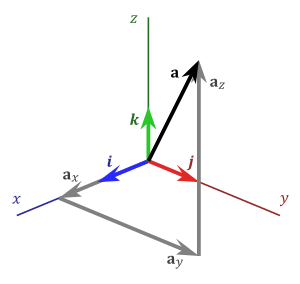Enter the x, y, and z coordinates of any vector to calculate the magnitude of that vector. Enter z as 0 if you need to calculate the magnitude of a vector in only the x and y planes.
- Unit Vector Calculator
- Vector Addition Calculator
- Reference Angle Calculator
- Parallel Line Calculator
Unit Vector Magnitude Formula
The following formula is used to calculate the vector magnitude in a 3-dimensional space.
|u| = √(x₁² + y₁² + z₁²)
The following formula is used to calculate the vector magnitude in a 2-dimensional space.
|u| = √(x₁² + y₁²)
Vector Magnitude Definition
A vector magnitude is defined as the total distance from the origin to the endpoint of the vector.
Calculating the vector magnitude in Euclidean space (the geometric space) is done through the use of trigonometry. You might be thinking to yourself, what does a triangle have to do with vectors? Well, a vector is actually a hypotenuse of a triangle with a base of x and a height of Y. Therefore, the magnitude of the vector can then be calculated just like the hypotenuse of a triangle.
Vector Magnitudes in 3-Dimensional Space

Now we know the magnitude of a vector can be calculated through the trigonometric function for calculating the hypotenuse of a triangle, but most vectors have points in the x, y, and z planes. If you take a look at the picture above, you can see how a third dimension is brought into play when talking about vectors.
Luckily, because of the fundamentals of geometry, adding in a third dimension does not overly complicate the formula for calculating a magnitude. Since the formula for the magnitude of a 2-D vector is equal to the square root of the sum of the squares of the x and y coordinates, the formula for a 3-D vector is almost the same. It’s the square root of the sum of the squares of the x, y, and z coordinate.
How to calculate vector magnitude
Now that we understand the formulas for calculating the vector magnitude, we can go over some examples of how to use them. First, let’s look at a 2-dimensional vector.
- Let’s assume we have a vector with the following coordinates, (45, 27)
- Now plug them into the formula as follows |u| = √(45² + 27²)
- Use a calculator and solve. This should yield 25.478…
- Finally, compare using the calculator above.
Next, we will go over an example of a 3 dimensional vector.
- Let’s assume we have a vector with coordinates (24,32,31)
- Plug them into the formula as follows, |u| = √(24² + 32² + 31²)
- Use a calculator and solve. This should yield 53.130…
- Finally, compare using the calculator above
As you can see, the process for calculating the magnitude of a vector is very easy. It’s a simple plug and calculate. For more related calculators click here.
